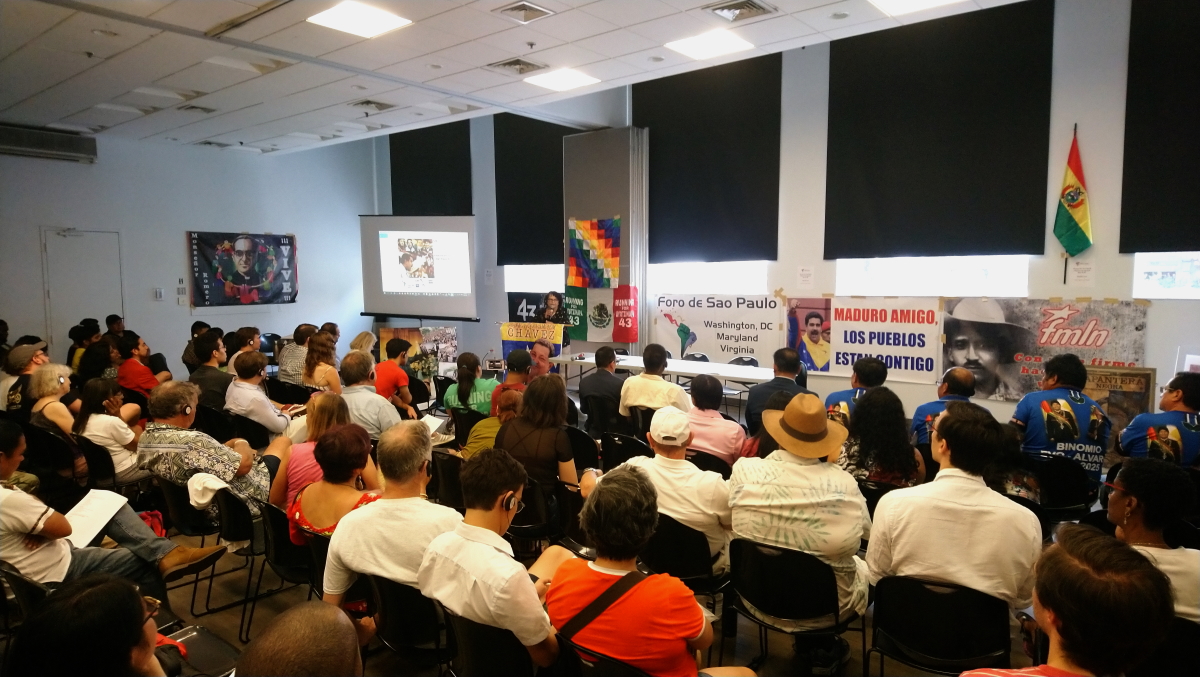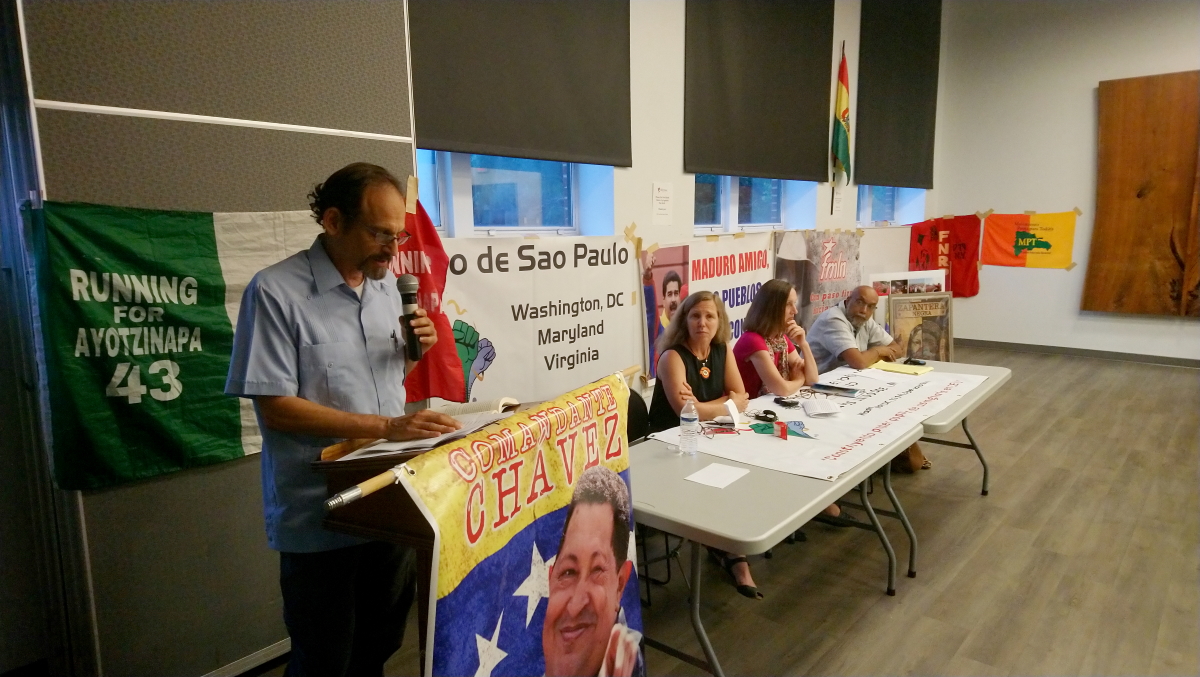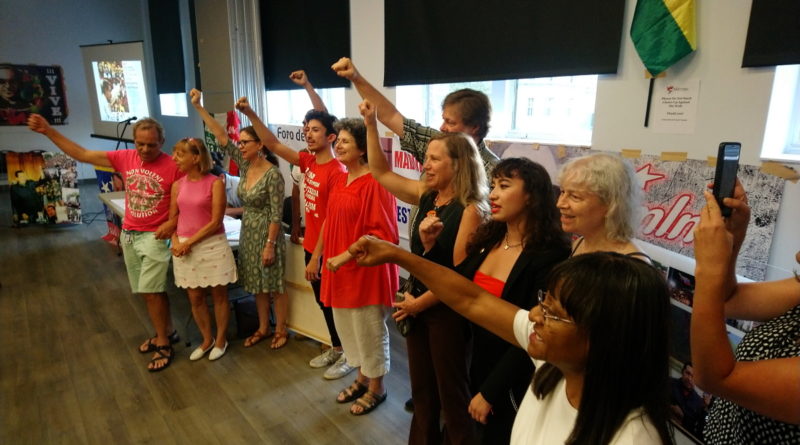Monroeism is the other side of Jim Crow, the side facing South
By Frederick B. Mills
Presentation before the Forum of São Paulo, Washington DC, on July the 20th, 2019
This Forum of São Paulo of Washington DC marks a significant step forward in building North-South solidarity on behalf of economic and social justice throughout the hemisphere and respect for the sovereign equality of nations. The Forum comes on the heels of the defense of the Venezuelan Embassy by the Embassy Protection Collective. It takes place amid growing nationwide direct action by the NeverAgainIsNow movement and allies to shut down the concentration camps and restore dignified treatment of Central American refugees. And it is held during days of protest over the failure of the Department of Justice to prosecute an NYPD police officer for the murder of Eric Garner, an officer who is still on the city payroll. These three experiences highlight the white supremacist link between the institutional racism within US borders and the neoliberal offensive by Washington and its right wing allies against Bolivarian resistance and the popular sectors in Latin America and the Caribbean.
The colonial wounds are still present
The Trump administration has stepped up the necropolitics[1] of white supremacy and plutocracy which now expresses itself in the police surveillance state at home and Monroeism abroad. Both expressions have common historical-ideological roots in European supremacy of the fifteenth century and the invention of the Americas [2]. Today, this ideology of conquest and subjugation continues to inflict colonial wounds[3] on Afro-descendant and Original Peoples. These wounds are the result of multiple hierarchies of domination[4], including race, class, gender identity, nationality, religion, and location.
The idea of a colonial wound is not to suggest fatalism; history is not over, nor is it exclusively written from the point of view of the Global North. Five hundred years of European aggression against Amerindia has been met by five hundred years of resistance. But not only resistance. Despite setbacks, the so-called “Pink Tide”[5] represents a significant advance of the decolonizing project that extends back to 1492 and will not cease until all of the peoples of Amerindia recover their sovereignty.

Peoples of the North and South, united
Today we come together, North and South, to affirm our co-responsibility for building a new world, one in which many worlds can fit, to use a Zapatista expression. Tonight I would like to examine three fronts in this project of transformation of which the Embassy Protection Collective, the protests against the concentration camps, and the outrage over police terror are emblematic.
I suspect something has changed in us, in a very positive way, as a result of 37 days of resistance by the Embassy Protection Collective and their supporters. The Collective defended the Venezuelan Embassy in Washington DC at the invitation of the constitutional government of President Nicolás Maduro. The Collective inside the embassy and supporters outside had to confront the racist, mysogenist, and homophobic attacks of many of those Guaidó supporters who voiced support for criminal US economic sanctions and US military intervention against their own people.
When it became clear that the Collective would not be intimidated by either the Guaidó supporters or the Secret Service, and support for the Collective in the streets was continuing to grow, the police seized the embassy grounds and arrested the members of the Collective who were inside. Since this police action was a serious violation of the Vienna Convention on Diplomatic Relations of 1961, the State Department lost moral and legal ground while the Collective fortified North-South solidarity and exposed the farcical nature of the shadow government of “interim president” Juan Guaidó.

The 2019 Annual Conference of the Forum of Sao Paulo in Washington DC, July 20th, 2019. (Photo credit: COHA)
The fight for fair inmigration policies
Here at home, we are also mindful of the struggle on the immigration front and, in particular, the broad based protests against the concentration camps and ICE raids. We see US citizens and immigrants marching together to defend the dignity of Central American refugees. Not only have thousands of activists across the US blocked entrances to the camps, in some towns, neighbors are coming out to stop ICE agents from seizing members of their community. This often spontaneous resistance extends the concept of sanctuary, which is institutional, to the practice of collective responsibility.
Racism at home and Neo-Monroeism abroad
With regard to police terror inflicted on people of color, there is widespread protest aimed at ending the impunity of police who commit murder as well as the systematic practice of racial profiling. These protests are part of a larger nationwide movement aimed at reforming a racist justice system and dismantling the increasingly repressive and militarized police/surveillance state.
In response to all three of these assaults on human and civil rights,–the Monroeist offensive in Latin America, the persecution of refugees, and the police state– there is a convergence of progressive forces which share certain core values in opposing what Martin Luther King Jr. called the three evils of militarism, poverty and racism. The alternative to necropolitics, as Argentine Mexican philosopher Enrique Dussel points out, is to defend the growth of human life in community and in harmony with the biosphere [6].
The Zapatista National Liberation Army (EZLN) expressed well the spirit of today’s North-South solidarity in their June 2005 Sixth Declaration from the Forest of Lacandona. The EZLN, at the time, was reflecting on more than a decade of struggle and international solidarity since the Indigenous uprising of 1994 in Chiapas.
“The first thing we see is that our hearts are not the same as before, when we began our struggle; it is bigger because now we have touched the hearts of many good people. And we also see our heart has been hurt, or we can say — more wounded. And it is not that it is wounded on account of the trickery perpetrated on us by bad governments, but that when we touch the hearts of others then we also touch their pains. It is as though we see ourselves in a mirror.”
Today our hearts too are not the same. In this moment of danger, we too can see ourselves as if in a mirror. And in this mirror we can identify a colonial wound caused by the same historic maladies. From the time of the conquest of Amerindia and the Trans-Atlantic slave trade up to contemporary Monroeism and the New Jim Crow[7], some currents in European and US political philosophy have justified the subjugation of non-European peoples. As early as 1550 a debate took place before the Royal Council of Valladolid over the humanity of the “Indians” and whether Spain was justified in waging war against them. For modern European political philosophy, the rights of “Man” were generally not intended for Africans, Indigenous peoples, women, or those without property.

Monroeism and the New Jim Crow: two sides of the same coin
We can still perceive the legacy of European supremacy, in case anyone has forgotten, in US exceptionalism. This exceptionalism claims noble ends, but its real face is manifested in a racist criminal justice system; in Washington’s drive to recolonize Latin America; and in the ongoing atrocity of concentration camps on US soil. Let’s be clear. Monroeism is the other side of Jim Crow, the side facing South.
The year 1989 revealed deep cracks in the historic claims of European and later US world supremacy. Political theorist Francis Fukuyama suggested that, with the fall of the Soviet Union (1989-91), the end of history was upon us. He did not mean the world was literally about to end, but that politics and economics had arrived at the definitive triumph of capitalism over socialism. But his pronouncement was premature. During that same year, there was an uprising by the bravo pueblo of Venezuela (the Caracazo) in response to neoliberal reform measures imposed by then President Carlos Andrés Pérez. The same champions of the idea that markets ought to be free from government interference had no qualms making use of the state’s monopoly on violence to impose the adjustment imperatives of finance capital on a nation in which the majority of citizens lived in abject poverty. Pérez authorized the military to use lethal force, and hundreds if not thousands of mostly poor, Afro-descendent, and working class Venezuelans were gunned down in the streets of Caracas.
The Monroe Doctrine versus the Bolivarian alternative
One year after the Caracazo, the first meeting of the Forum of Sao Paulo in 1990 was held in Brazil to discuss ways to reverse the neoliberal tide that had exacerbated economic inequality, privatized public services, eroded labor rights, compromised national sovereignty, and imposed austerity in the name of an ever elusive future prosperity. Ten years later, in December of 1998, Hugo Chávez would be elected president of Venezuela on a popular platform which offered an alternative to the neoliberal model, a Bolivarian alternative.

Over the past two decades, one of the principal targets of Monroeism has been Venezuela, not only on account of its oil reserves and other natural resources but also because, since the election of Chávez in December of 1998, this Bolivarian Republic has defied the Washington agenda. This defiance involved forging a path towards regional independence and integration, a path that ushered in the Pink Tide of progressive governments and social movements which lifted millions out of poverty, reclaimed national sovereignty over natural resources, and revalorized the cultures of Original and Afro-descendant peoples.
In the face of a US-NATO alliance bent on world domination, the Bolivarian alternative has welcomed the emergence of a multipolar world. As a result, and in direct collision with Monroeism, the Bolivarian revolution has led to an expansion of commerce between Latin America and China, Russia, and other trading partners. In the eyes of US policy makers from both major political parties, the unpardonable offense of Cuba, Nicaragua, Bolivia, and Venezuela has been to assert their independence, diversify their trading partnerships, and chart post-neoliberal and post-colonial alternatives to the Washington consensus.
Monroeism inflicts a colonial wound in the South and the New Jim Crow keeps open analogous wounds in the North. But the two faces of the ‘coloniality of power’ (to use Anibal Quijano’s term) are manifest in Trump’s zero tolerance immigration policy, a policy for which Obama’s mass deportation machine paved the way. The Central American refugee is a victim of both Monroeism and white nationalism. Context is critical here. The Obama administration created the conditions driving refugee flows out of Honduras by backing the coup against democratically elected President Manuel Zelaya in June 2009, which led to a repressive regime; the imposition of neoliberal experiments; and a rapid deterioration in public security. But that’s not all. The Trump administration and the Organization of American States (OAS) dealt a fresh blow to pro-democracy forces in Honduras by backing a stolen election in 2017[8]. It is these historic blows to democracy that have led to the current Honduran migration north. Those Honduran and other Central American migrants, who survive the trek through Mexico to seek asylum in the US, now face the dehumanizing ordeal of concentration camps, family separation, or deportation. Some have already died as a result of their internment.
US necropolitics: at home and abroad
Grassroots resistance to the necropolitics that has come to characterize US domestic and foreign policy is growing. The unavoidable faces of the victims of the prevailing system, both at home and abroad, are increasingly becoming the bad conscience of an exhausted liberalism. What centrist Democrats cannot fathom is that there is no way out of the wasteland created by neoliberal capitalism short of transforming the prevailing economic system, and this means pushing back against the increasingly coercive mechanisms of social control.
The rehabilitation of Monroeism and the New Jim Crow have both been the result of deliberate US bipartisan projects. For example, thanks to bipartisan consensus, the war on drugs has led to mass incarceration. The endless war on terror continues to provide political cover for the militarization of policing and universal domestic surveillance. Yet even the FBI acknowledges that the main source of domestic terrorism comes from the ranks of white supremacists.
We also recall that it was President Barack Obama’s rehabilitation of Monroeism that began the US offensive against progressive governments, political parties, and social movements in Latin America. Trump is merely taking off the mask of bedrock US institutional racism and militarism that has been festering long before he was elected president. Trump is no lone villain; he reflects the entrenched interests of the corporate state.
What the corporate parties generally omit from their analyses of domestic and foreign policy is the common historical-ideological roots of Neo-Monroeism and the New Jim Crow, both of which are, in some sense, two sides of the same coin. While no doubt the impact of these twin maladies on their victims is conditioned by local factors, both inflict colonial wounds. By decolonizing our way of comprehending history, we are more likely to overcome the present dangers, and, in North-South solidarity, advance towards building “a world in which many worlds fit”.
Fred Mills is an academic, and Co-Director of COHA
___________________
End notes
[1] A term used by Achille Mbembe in the essay “Necropolitics” (2003) to refer to a politics that determines who lives and who dies.
[2] See Dussel, Enrique. (1995) The Invention of the Americas: Eclipse of “the Other” and the Myth of Modernity. New York: Continuum.
[3] In a Jan. 23, 2017 interview Walter Mignolo argues that “The colonial wound refers to racism and sexism and the social classifications that ensue from them.” In Activism, Trajectory, and Key Concepts. Alvina Hoffmann. E-International Relations.
[4] A term used by Peruvin sociologist, Aníbal Quijano to describe some of the basic features of the “coloniality of power”.
[5] “Pink Tide” represents the revolutionary and progressive wave of governments initiated by the election of President Hugo Chávez in Venezuela in 1998, followed by the election of several other new leaders, among them Evo Morales in Bolivia, Néstor Kirchner and Cristina Fernández de Kirchner in Argentina, Lula da Silva in Brazil, and Rafael Correa in Ecuador.
[6] See, for example, Dussel, E. (1998). Ética de La Liberación en La Edad de La Globalización y La Exclusión. Madrid: Editorial Trotta.
[7] See Alexander, Michelle (2010). The New Jim Crow: Mass Incarceration in the Age of Colorblindness. New York: The New Press.
[8] There were irregularities reported in the Hunduran presidential election of 2013. See (Nov. 30, 2013) Nicholas Phillips and Elisabeth Malkin. Honduras Election Results Challenged. New York Times. https://www.nytimes.com/2013/12/01/world/americas/honduras-election-results-challenged.html.


